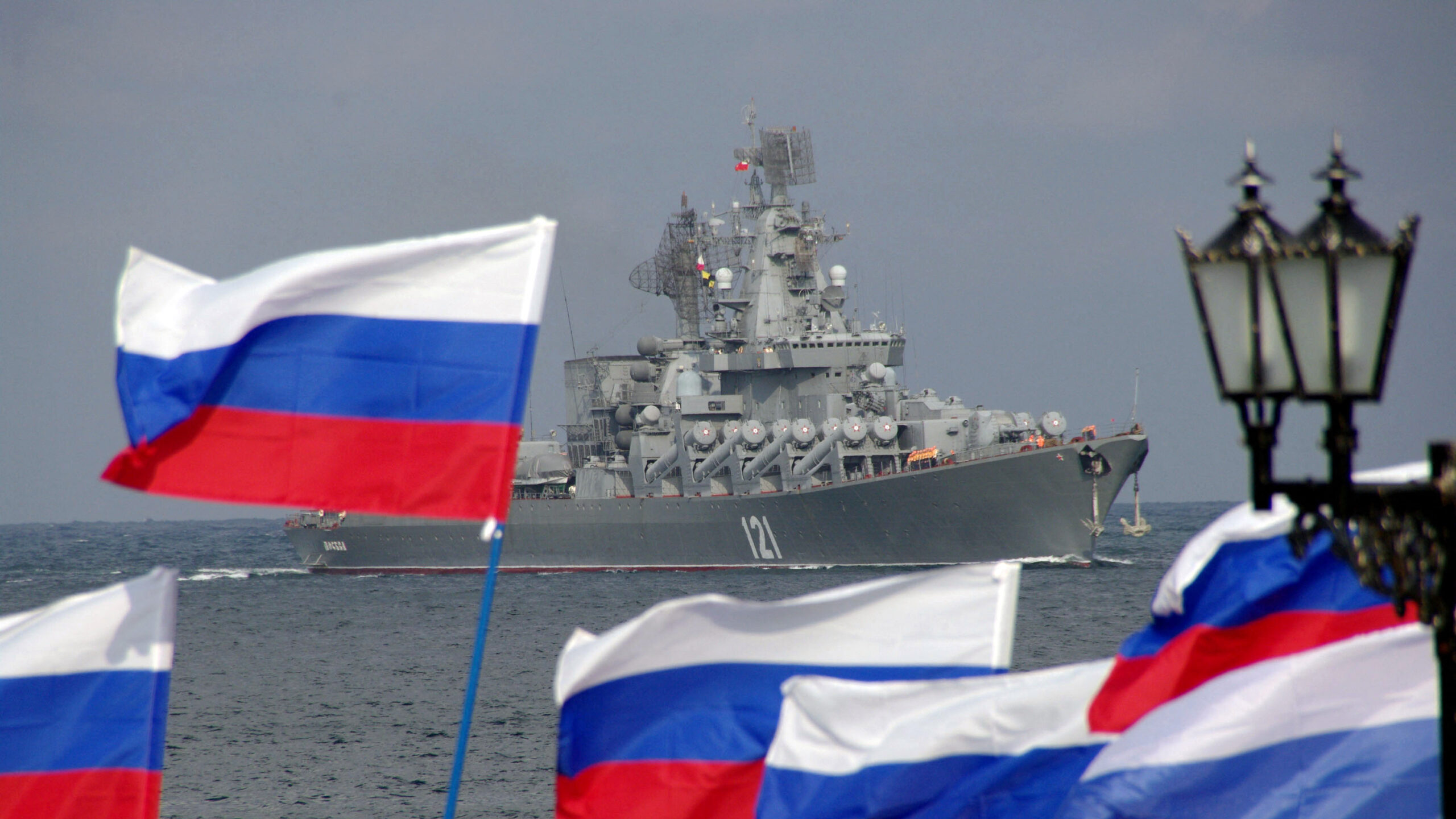
The Russian missile cruiser Moskva, a flagship of Russian Black Sea Fleet, enters Sevastopol bay. (Photo by VASILY BATANOV/AFP via Getty Images)
WASHINGTON: Even as Ukraine has proved its military tenacity in ground fighting against Russian troops, observers of the conflict were stunned late this week after the Ukrainian military announced it successfully struck the Russian Black Sea fleet’s flagship with a pair of cruise missiles.
The notion of Ukraine’s military, the veritable underdog in the fight, bringing down the Moskva, a warship named for Russia’s capital city, was not only a strategic victory but a symbolic one.
Russia’s defense ministry put out a variety of statements suggesting the ship suffered an accidental fire or explosion, but today a senior US defense official told reporters the ship was indeed hit by two Ukrainian Neptune missiles.
But just as analysts were calculating what the Russian loss meant for the future of the European conflict, the sinking of such a high-profile ship also prompted a more introspective question for some US naval observers: If Ukraine could sink a flagship vessel with a cruise missile, how well would American ships do in a similar situation, as it could see in, for example, the Indo-Pacific against China?
The answer, three naval warfare experts told Breaking Defense, is complicated, but generally the US Navy is much better positioned to defend against or recover from such an attack.
Anti-ship munitions are relatively inexpensive and the Chinese have invested in plenty of them, making the threat very real. But Russia’s surface fleet’s ship designs are outdated and flawed in ways that lend them to catastrophic results from even a single successful hit. Their defenses also haven’t been updated as vigorously as America’s. Further, the apparent incompetence of Russia’s crews likely played a key role in the ship’s inability to recover following the strike — a skill US Navy sailors have demonstrated time and again.
“The USN does confront a major problem against the Chinese in the Indo-Pacific” with respect to its cruise missiles, said Collin Koh, a research fellow at the Nanyang Technological University in Singapore. “Yet on the flipside, the PLA Navy is also steadily building principal surface combatants, and if the US military is able to enhance its anti-ship arsenal then a counter-threat can be posed to the Chinese in the same manner.”
(Relatively) Small Munitions, Big Impacts
Capable anti-ship cruise missiles are readily available in the global arms market, and China, for one, has amassed a “potent arsenal” of them, according to Koh.
To be effective, Koh said, a missile doesn’t have to sink a ship outright — it just needs to do enough damage that the crew’s attention is diverted from launching attacks to keeping themselves afloat. If a weaker force focuses large numbers of missiles on a single ship, they have good odds of landing one or two useful hits.
Details of the Moskva’s final moments above water are still foggy, but there is consensus that the ship did not sink immediately following the strike, but rather succumbed to the damage while transiting back to port.
The Israeli Navy experienced a similar incident in 2006 when the Iran-backed Lebanese group Hezbollah managed to strike the corvette INS Hanit from land, Koh noted.
“The strike didn’t sink the warship [Hanit] but put it out of action. This incident, and the latest Moskva sinking, reinforces the notion that in today’s naval warfare, weaker parties can still pose an asymmetric threat to stronger naval adversaries,” he said.
The Importance Of Ship Design, Upgraded Defenses And Steady Sailors
But there are a few reasons it may be apples and oranges to compare the Moskva and ships in the US Navy’s current surface force.
The first has to do with the design of the Moskva and other Soviet fleet ships, said Jerry Hendrix, a retired US Navy captain and a senior fellow with the Sagamore Institute based in Indianapolis. Produced in the 1970s and 1980s, the Soviet Union chose to store offensive weaponry above deck. That means it only takes one well placed hit to start a fire, which then heats up the canisters storing the missiles, transforming them into ticking time bombs.
“I don’t think that we can understate just the inherent poor design of the Slava class or for that matter, the Kirov class, or the Udaloys that came out at this time,” Hendrix said, referring to different Soviet-era ship types still in service. “This particular design of ship that the Russians or the Soviet Union invested in significantly really sets itself up for the sort of cascade failure.”
By contrast, the US Navy stores offensive munitions below deck, meaning if a fire threatens to start “cooking” a missile, then the crew can quickly flood the space before more damage is caused.
Another issue, Hendrix said, was the Russian’s surface fleet, which has not seen as much investment and attention as its more capable submarine force, has “archaic” air defense systems that simply aren’t designed for the trajectories of modern cruise and ballistic missiles, nor are they sensitive enough to pick up smaller contacts. The US Navy’s Aegis Combat System, on the other hand, has been persistently upgraded for decades to adapt to new threats.
“Our Aegis platforms have been designed, and then upgraded, and modified specifically looking everywhere from the surface to ballistic missile trajectories, which are coming down nearly vertically,” he said. (Aegis reportedly intercepted a missile attack on a US ship off the coast of Yemen in 2016.)
James Foggo III, a retired four-star Navy admiral who now leads the Center for Maritime Strategy, told Breaking Defense today the crews themselves are also key factors in whether a ship can overcome an attack.
He noted the timing of Moskva’s sinking coincides with the upcoming 40th anniversary of the Falklands War. In that conflict, there were two vessels, one British and one Argentine, that were destroyed in eerily similar incidents to what happened to the Russian warship.
In both cases, Foggo said, the crews should have been able to either defend against the attack or at least mitigate the damage after the fact. In both cases, the crews failed to do either.
The Argentine ship had watertight doors, designed to isolate flooding in the event an attack breaches the hull. The crew’s inability to control the flooding indicated a poor state of readiness on their part, Foggo said. In the British ship’s case, the crew reportedly failed to see the missile coming. Subsequently, the ship caught fire which spread and destroyed the vessel before it could return to port, he said.
“I don’t have any facts other than speculation [about the Moskva], but I will tell you that it smacks of the situation on [the Argentine ship]. Complacency,” he said.
‘It’s An Embarrassment To Putin’
Although Russia’s defense ministry refuses to credit Moskva’s transformation into an artificial reef to Ukraine, it does acknowledge the ship is gone. And that is likely a very hard pill for the Russians to swallow.
Sending the warship named after the country’s capital into this war “was essentially Moscow sending a signal that we’re here and we’re going to stay,” said Hendrix. “So don’t underestimate the impact of the loss of this ship… It’s an embarrassment for Putin. It’s an embarrassment for Russia, and it is a real blow to the national prestige of Russia.”
Foggo said he was particularly concerned about what retaliatory measures the Russians would take after losing a flagship. He said many countries’ flagships are typically well-maintained, and relatively state-of-the-art vessels that are meant to represent the best of a nation. Moskva was rumored to be Putin’s favorite.
Foggo also pointed outed there is an irony about Moskva’s fate, and its status of flagship. Early on in the Russian invasion, the Ukrainian government ordered its own navy’s flagship, the frigate Hetman Sahaidachny, to be scuttled, or intentionally sunk, in Nikolaev port northeast of Odesa in order to keep the Russians from seizing it. Foggo said that the Moskva and other ships in its class were built at the same port when Ukraine was part of the USSR.
“And that’s where the Ukrainian flagship remains sunk. And now the Ukrainians, if it’s true, sunk Moskva, the flagship of the Black Sea Fleet,” he said. “It’s just — I mean, you can’t make this up. It’s like a Hollywood script.”
Invest in the US industrial base to support our Navy and AUKUS: Raven
In this op-ed, Under Secretary of the Navy Erik Raven lays out why he believes Congress should support the service’s 2025 budget request.


























